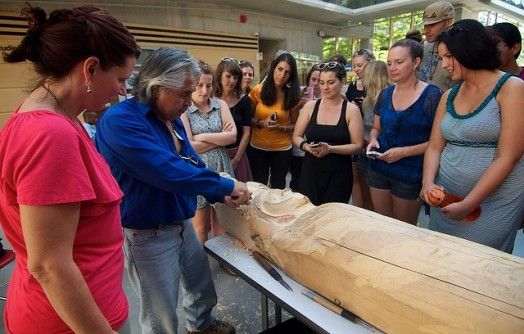[dt_button link=”http://d165vjqq8ey7jy.cloudfront.net/mp3/27341/se-8143s.mp3″ target_blank=”true” button_alignment=”default” animation=”fadeIn” size=”small” style=”default” bg_color_style=”custom” bg_color=”#333333″ bg_hover_color_style=”custom” bg_hover_color=”#444444″ text_color_style=”custom” text_color=”#ffffff” text_hover_color_style=”custom” text_hover_color=”#dddddd” icon=”fa fa-cloud-download” icon_align=”left”]Yuklash[/dt_button]
[dt_divider style=”thin” /]
Transcript:
Voice 1
Welcome to Spotlight. I’m Robin Basselin.
Voice 2
And I’m Ryan Geertsma. Spotlight uses a special English method of broadcasting. It is easier for people to understand, no matter where in the world they live.
Voice 1
Isadore Charters stands on a beautiful hill in the country of Canada. He looks out at the fields of grass. He sees mountains in the distance. Charters’ hair is now grey. But he remembers many happy days on these hills. When he was a child, he ran over the grass and climbed trees. But when he was young, nobody called him Isadore Charters. The only name he knew was Yenmo Ceetza. His family called him Yummo. But one sad day, officials took Yummo away. They placed him in a government school, far away from his family. And they called him Isadore Charters. Officials took Charters away from everything he knew. And it has taken him many years to find peace and recover from this hurt. Today’s Spotlight is on Isadore Charters and his story of faith and healing.
Voice 2
Charters is a member of the Okanagan and Thompson tribes. These are two of Canada’s first nations – the aboriginal people who lived in Canada before Europeans arrived. Charters’ ancestors had lived in the hill country of Western Canada for thousands of years.
Voice 1
As a child, Charters loved his tribe. And he loved living on their land. But when he was 6 years old, his life changed. One morning a truck came to his home. Officials took Charters and his brothers. They put the boys in the truck. The truck was filled with other crying children. All the children were from aboriginal tribes. And the government was placing them in government managed residential schools – far from their homes. The Canadian government threatened the aboriginal parents. If they did not send their children to the residential school, the government would send the parents to prison.
Voice 2
This is a common story for many aboriginal tribe members in Canada. From 1876 to 1996, the Canadian government forced 150,000 aboriginal children to attend residential schools. The goal of these schools was to force aboriginal children to become part of the majority culture. School officials worked to rid Canada of aboriginal culture.
Voice 1
Charters lived at a residential school managed by the Catholic Church. When he arrived, a nun told him that his name was not Yummo. This female religious worker told him that his English name was Isadore Charters. And from then on, she said that he must only be Isadore Charters. The nuns told Charters that aboriginal culture was evil. They said that he needed to forget the ways of his tribe. And they did not let him speak his tribal language. Charters told the Chilliwack Progress news organization,
Voice 3
“They took away who I was – my language, my traditions, my culture.”
Voice 2
But one of the nuns at the school was very kind to Charters. She talked about the love of God and her Christian faith. At times, Charters said he could feel God even at the school. Over time, Charters struggled with the idea of becoming a Christian. The school was managed by Christian leaders that did not respect him or his culture. But he believed strongly in God and he wanted to become a saint – a holy person of the Christian church. So one day, he got on his knees. He placed his back towards the school and his face towards the grass of the fields. He told God that he wanted to become a saint. Charters told Spotlight,
Voice 3
“God was there. We were talking. He was talking to me, and I knew he was there.”
Voice 1
But very soon after that, Charters stopped believing in God. He experienced a terrible tragedy. A worker at the school began to molest him. This person forced Charters to perform sexual acts with him.
Voice 2
Charters became very angry – at the worker and at God. He began using art to express his pain and anger. He made pictures of snakes coming out of peoples’ mouths and pictures with knives and blood. After a short time, Charters began to drink alcohol. He thought alcohol would help get rid of his pain. By the time he was 12 years old, Charters was an alcoholic. He could no longer control his use of alcohol.
Voice 1
As an adult, Charters recognized that he needed to stop drinking. After many years, he decided to seek help. He looked to God and his aboriginal culture. Members of other tribes helped him. They prayed with him and encouraged him. This time was very healing for Charters. He came to recognize that he did not have to give up his culture to be a Christian. And he did not have to stop being a Christian to honor his culture.
Voice 2
Charters believes that God was speaking to his aboriginal people all through their history. He thinks that their beliefs prepared them to hear the message of Jesus Christ. He told Spotlight,
Voice 3
“Our people already knew there was a special person on the earth…That is why it is easy for them to believe in Jesus.”
Voice 1
After he stopped drinking, Charters went to art school. Today, he uses art to express the healing he has experienced – instead of only pain and anger. He paints pictures of aboriginal stories that he remembers from his childhood.
Voice 2
Charters also believes that there needs to be healing between the larger Canadian and first nation cultures. So, Charters proposed an idea to help share his story and encourage healing. He decided to carve a totem pole. Totem poles are important in the aboriginal culture of Western Canada. A totem pole is a tall piece of wood. An artist uses sharp tools to carve pictures and symbols in the pole. These pictures tell a story.
Voice 1
Charters decided that he would carve a totem pole that told the story of his healing. And he wanted other people to help him carve it. So, Charters travels to schools, universities, churches and public places. He tells his story, and then he invites people to help him. He gives them sharp tools to carve. Then, they can be a part of the healing – not just Charters’ healing, but Canada’s healing.
Voice 2
When the healing pole is finished, Charters will take it to the residential school where he lived. This particular school was one of the largest residential schools in Canada. There, the pole will be permanently placed in the ground. The community is already planning a celebration to honor the totem pole. The community will perform a first nation power dance. Then, they will pray together. And the very place that caused so much pain will become a place of hope for the future.
Voice 1
The writer of this program was Jennifer Hawkins. The producer was Michio Ozaki. The voices you heard were from the United States. All quotes were adapted and voiced by Spotlight. You can listen to this program again, and read it, on the internet at www.radioenglish.net. This program is called, “Isadore Charters: The Healing Pole.”
Voice 2
We hope you will join us again for the next Spotlight program. Goodbye!




